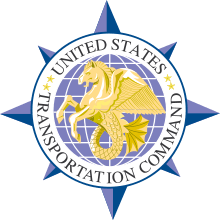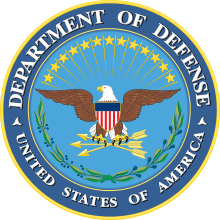United States Transportation Command
| Transportation Command | |
|---|---|
|
Emblem of USTRANSCOM | |
| Active | 1987 – present |
| Country |
|
| Type | Functional Combatant Command |
| Role | Provides air, land, and sea transportation for the Department of Defense in times of peace and war. It moves people and property around the world.[1] |
| Part of |
|
| Headquarters | Scott Air Force Base, Illinois, U.S. |
| Nickname(s) | USTRANSCOM |
| Motto(s) | Together, We Deliver. |
| Colors | Purple |
| Mascot(s) | Spunky |
| Commanders | |
| Current commander | Gen Darren W. McDew, USAF ,[2] |
| Deputy commander | LTG Stephen R. Lyons, USA[3] |
The United States Transportation Command (USTRANSCOM) is one of nine unified commands of the United States Department of Defense. The command is located at Scott Air Force Base, Illinois, was established in 1987. USTRANSCOM is a syllabic abbreviation formed from United + States + TRANSportation + COMmand.
This command is the single manager of the United States' global defense transportation system. USTRANSCOM is tasked with the coordination of people and transportation assets to allow the US to project and sustain forces, whenever, wherever, and for as long as they are needed. The commander of USTRANSCOM is General Darren W. McDew, formerly head of the Air Mobility Command, the air component of TRANSCOM, who was confirmed in August 2015.[5]
Mission
USTRANSCOM provides full-spectrum global mobility solutions and related enabling capabilities for supported customers' requirements in peace and war.[6]
Components
USTRANSCOM coordinates missions worldwide using both military and commercial transportation resources. It is composed of three service component commands: The Air Force's Air Mobility Command, the Navy's Military Sealift Command and the Army's Surface Deployment and Distribution Command. The Joint Enabling Capabilities Command, which was part of the former U.S. Joint Forces Command, is now part of the U.S. Transportation Command.
Air Mobility Command (AMC), the air component of USTRANSCOM, is also located at Scott AFB. The AMC fleet can provide refueling capability and deliver people and cargo anywhere around the globe in a matter of hours. Aircraft assets of the command include: C-17 Globemaster III, C-5 Galaxy, C-130 Hercules, KC-135 Stratotanker, and KC-10 Extender. Additional long-range airlift aircraft are available during national emergencies through the Civil Reserve Air Fleet, a fleet of commercial aircraft committed to support the transportation of military forces and material in times of crisis.
Military Sealift Command (MSC) USTRANSCOM's sealift component, provides efficient sea transportation worldwide for DoD in peace and war. Located in Washington, D.C., MSC uses a mixture of government-owned and commercial ships for three primary functions: Surge sealift, principally used to move unit equipment from the United States to theaters of operations all over the world; prepositioned sealift, comes under USTRANSCOM's command once the ships have been released into the common-user fleet; and sustainment sealift, the life line to keep deployed forces continuously supplied. MSC assets include Fast Sealift and Ready Reserve Force ships. In addition, MSC charters and books space on commercial ships.

Military Surface Deployment and Distribution Command (SDDC), located at Scott Air Force Base, Illinois, is the commercial surface lift component and primary surface distribution manager for USTRANSCOM. SDDC's mission is to provide global surface deployment command and control and distribution operations to meet National Security Objectives in peace and war. SDDC has a presence in 24 water ports worldwide. In an average year, SDDC manages and directs the movement of 3.7 million measurement tons (4.2 million m³) of ocean cargo, 500,000 personal-property moves, 600,000 domestic freight shipments, 72,000 privately owned vehicles and 518,000 passengers. SDDC assets include 10,000 containers and 1,350 railroad cars. Within the United States, the SDDC works with the Federal Highway Administration to designate the Strategic Highway Network.
Joint Operational Support Airlift Center (JOSAC) specializes in the airlift of senior defense officials within the continental United States. JOSAC is located at Scott Air Force Base, Illinois.
Joint Enabling Capabilities Command (JECC) provides mission-tailored, ready joint capability packages to combatant commanders in order to facilitate rapid establishment of joint force headquarters, fulfill Global Response Force execution and bridge joint operational requirements. JECC is located at Naval Station Norfolk, Virginia and is divided into three subordinate joint commands that provide capabilities across seven unique functional areas to bring tailored, mission-specific forces to a joint force commander within hours of notification. The JECC subordinate joint commands are:
- Joint Planning Support Element (JPSE) – Provides rapidly deployable, tailored, ready, joint planners, operators, logisticians, knowledge managers and intelligence specialists in order to accelerate the formation and increase the effectiveness of newly formed joint force headquarters. JPSE is co-located with the JECC headquarters at Naval Station Norfolk, Virginia.
- Joint Communications Support Element (JCSE) – Provides rapidly deployable, en route, early entry and scalable command, control, communications, computer, intelligence, surveillance and reconnaissance (C4ISR) capabilities across the full spectrum of operations in order to facilitate rapid establishment of joint force headquarters and bridge joint C4ISR requirements. JCSE is located at MacDill Air Force Base, Florida.
- Joint Public Affairs Support Element (JPASE) - Provides ready, rapidly deployable, joint public affairs capabilities to combatant commanders in order to facilitate rapid establishment of joint force headquarters, bridge joint public affairs requirements and conduct public affairs training to meet theater information challenges. JPASE is located in Suffolk, Virginia.
History

World War II, the Berlin blockade, the Korean War, and the Vietnam War all demonstrated that the United States needed to maintain a capable and ready transportation system for national security. In 1978, however, command post exercise Nifty Nugget exposed great gaps in understanding between military and civilian participants: mobilization and deployment plans fell apart, and as a result, the United States and its NATO allies "lost the war". Two major recommendations came out of Nifty Nugget.[7] First, the Transportation Operating Agencies (later called the Transportation Component Commands) should have a direct reporting chain to the Joint Chiefs of Staff (JCS). Second, the JCS should establish a single manager for deployment and execution. As a result, the JCS formed the Joint Deployment Agency (JDA) at MacDill Air Force Base in Florida in 1979.
Despite its many successes, the JDA could not handle the job. Although the JDA had responsibility for integrating deployment procedures, it did not have authority to direct the Transportation Operating Agencies or Unified and Specified Commanders in Chief to take corrective actions, keep databases current, or adhere to milestones. According to several independent studies on transportation, the Department of Defense (DOD) needed to consolidate transportation. Consequently, President Ronald Reagan on 18 April 1987 ordered the Secretary of Defense to establish a Unified Transportation Command (UTC), a directive made possible in part by the Goldwater-Nichols Department of Defense Reorganization Act of 1986, which revoked the law prohibiting consolidation of military transportation functions.
The UTC Implementation Plan (IP) outlined the new unified command's responsibilities, functions, and organization. Christened United States Transportation Command (USTRANSCOM), its mission was to "provide global air, sea and land transportation to meet national security needs". It had three transportation component commands—the Air Force's Military Airlift Command (replaced by Air Mobility Command in 1992), the Navy's Military Sealift Command, and the Army's Military Traffic Management Command, (renamed Military Surface Deployment and Distribution Command in 2004). The JDA's missions and functions transferred to USTRANSCOM on 18 April 1987, when the agency became the command's Directorate of Deployment. Additionally, the IP located the command at Scott AFB, to take advantage of Military Airlift Command's expertise in command and control. On 22 June 1987, the President nominated Air Force Gen. Duane H. Cassidy as the first Commander, USTRANSCOM, and on 1 July the Senate confirmed the recommendation, thus activating the command at Scott. The commander of USTRANSCOM received operational direction from the National Command Authority (NCA) through the Chairman of the Joint Chiefs of Staff.
USTRANSCOM appeared, at first glance, to be the long sought after remedy for DOD's fragmented and often criticized transportation system. Its establishment gave the United States, for the first time, a four-star, unified combatant commander to serve as single-point-of-contact for Defense Transportation System (DTS) customers and to act as advocate for the DTS in DOD and before Congress. But it soon became apparent that, in reality, the nation's newest unified command was created half-baked. The IP allowed the Services to retain their single-manager charters for their respective transportation modes. Even more restrictive, the document limited USTRANSCOM's authorities primarily to wartime.
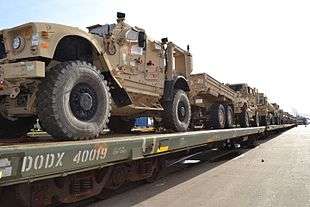
As a result, during peacetime, USTRANSCOM's component commands continued to operate day-to-day much as they did in the past. They controlled their industrial funds and maintained responsibility for service-unique missions, service-oriented procurement and maintenance scheduling, and DOD charters during peacetime single-manager transportation operations. They also continued to have operational control of forces. It took a wartime test by fire, Desert Shield/Desert Storm, to bring to maturity a fully operational, peacetime and wartime, USTRANSCOM.
The strategic deployment for Desert Shield/Desert Storm ranks among the largest in history. USTRANSCOM, in concert with its components, moved to the United States Central Command area of responsibility nearly 504,000 passengers, 3.7 million measurement tons (4.2 million m³) of dry cargo, and 6,100,000 short tons (5,500,000 t) of petroleum products in approximately seven months. This equated roughly to the deployment and sustainment of two Army corps, two Marine Corps expeditionary forces, and 28 Air Force tactical fighter squadrons.
The DOD learned much from the deployment to the Persian Gulf, and foremost among those lessons was that USTRANSCOM and its component commands needed to operate in peacetime as they would in wartime. Consequently, on 14 February 1992, the Secretary of Defense gave USTRANSCOM a new charter. Stating the command's mission to be "to provide air, land and sea transportation for the Department of Defense, both in time of peace and time of war," the charter greatly expanded the authorities of the USTRANSCOM commander. Under it, the Service Secretaries assigned the components to the USTRANSCOM commander in peace and war. In addition, the military departments assigned to him, under his combatant command, all transportation assets except those that were service-unique or theater-assigned. The charter also made the USTRANSCOM commander DOD's single-manager for transportation, other than service-unique and theater-assigned assets.
Because USTRANSCOM must respond quickly in support of United States interests worldwide, the command must focus its attention across a full spectrum of support from humanitarian operations to contingencies. In 1995, USTRANSCOM supported 76 humanitarian missions and 94 Joint Chiefs of Staff exercises, visiting approximately 80 percent of the 192 countries.
Since Desert Shield/Desert Storm, USTRANSCOM has continued to prove its worth during contingencies—such as Desert Thunder (enforcement of UN resolutions in Iraq) and Allied Force (NATO operations against Serbia)--and peacekeeping endeavors—for example, Restore Hope (Somalia), Support Hope (Rwanda), Uphold Democracy (Haiti), Joint Endeavor (Bosnia-Herzegovina), and Joint Guardian (Kosovo). Likewise, the command has supported numerous humanitarian relief operations transporting relief supplies to victims of natural disasters at home and abroad. After the 9/11 terrorist attacks, USTRANSCOM became a vital partner in the United States' Global War On Terrorism supporting the warfighter in Operation Enduring Freedom (Afghanistan) and Operation Iraqi Freedom (Iraq). From October 2001 to the present, USTRANSCOM, its components, and its national partners have transported over 2.2 million passengers and nearly 6,100,000 short tons (5,500,000 t) of cargo in support of the war on terrorism.
On 16 September 2003 Secretary of Defense Donald H. Rumsfeld designated the Commander, USTRANSCOM as the Distribution Process Owner (DPO) to serve "as the single entity to direct and supervise execution of the Strategic Distribution system" in order to "improve the overall efficiency and interoperability of distribution related activities—deployment, sustainment and redeployment support during peace and war." With the most capable and ready air, land, and sea strategic mobility forces in the world, and with the authorities as the DPO, USTRANSCOM will continue to support the United States and its allies, in peace and war.
Current Activities

As future conflicts become increasingly dynamic, U.S. forces require the agility to respond quickly, across traditional regional boundaries with a variety of strategic capabilities. Emerging contested environments, to include cyber, pose a significant challenge to the transportation and distribution networks in the mid- to long-term range, and require careful consideration of how to protect those networks. Sea-lanes, which have not been contested for U.S. forces since World War II, will likely be contested in the next major contingency. The assumption that United States forces will have uncontested access to international airspace and sea-lanes in the future is likely no longer valid. USTRANSCOM is working with the military services and geographic combatant commanders to determine ways to protect those crucial strategic lanes.
Cyber threats remain a major concern for USTRANSCOM. Because of its extensive use of commercial capabilities, nearly 90 percent of USTRANSCOM missions are executed over unclassified and commercial networks. USTRANSCOM’s Joint Cyber Center (JCC) uses a process knows as the Cyber Staff Estimate to assess risk, adjust defensive posture, and adopt operational or technical mitigations in performance of key missions. USTRANSCOM integrates cyber security language into a majority of its commercial contracts and co-chairs the National Defense Transportation Association Cybersecurity Committee.
Ensuring the United States’ ability to fight at the time and place of its choosing requires enhanced readiness and improved future capabilities. The ability to project rapid power anywhere on the globe at any time sets the U.S. apart from the world, and to maintain this strategic advantage, USTRANSCOM ensures the US have the appropriate personnel, platforms, systems and training to maintain the strategic advantage.
Airlift and Aerial Refueling
Airlift forces move critical cargo and people to the point of need, while air refueling capabilities enable projection of forces across great distances to any location at any time. The Air Force’s primary · airlift workhorse, the Boeing C-17 Globemaster III, remains the backbone of the United States’ strategic airlift capability. To continue the C-17’s airworthiness, and meet Federal Aviation Administration (FAA) 2020 mandates, the Air Force has planned a series of modifications for the early 2020s and is pursuing a mitigation plan to restore 16 of their C-17 aircraft from Backup Aircraft Inventory to Primary Mission Aircraft Inventory.
The Lockheed C-5 Galaxy fleet is currently undergoing a Reliability Enhancement and Re-engining Program modification through April 2018, which has delivered increased mission capable rates and will extend service life past 2040.
The Boeing KC-46 Pegasus will be critical to the entire joint and coalition force’s ability to project combat power worldwide and give the United States and its allies an unparalleled rapid response capability for combat and disaster relief operations alike.
USTRANSCOM is implementing initiatives through the Civil Reserve Air Fleet (CRAF) contract to ensure wartime readiness capability while simultaneously offering best-value services for steady-state peacetime commercial augmentation.
Additionally, USTRANSCOM is building partnership capacity with other nations possessing air refueling competencies. Greater interoperability among nations will strengthen coalition partnerships and provide additional capability to the combatant commands.
Surface
Civil sector transportation infrastructure enables the movement of military forces. The Defense Personal Property Program (DP3), administered by SDDC, enables the movement and storage of service member, DoD employee, and U.S. Coast Guard (USCG) employee personal property and privately-owned vehicles, by leveraging best-value transportation decisions and traffic management expertise in accordance with the Defense Transportation Regulation. DP3, in collaboration with Transportation Service Providers (TSP), manages over 550,000 personal property shipments for DoD and USCG customers at an annual cost of $2 billion.
The Defense Personal Property System (DPS) and its associated Program Management Office provide a centralized, web-based, single-point interface system for worldwide shipment of personal property. The DPS is a self-service system, offering real-time access for government, industry and customer users to input and retrieve data supporting the entire movement process – from pick-up to delivery of household goods.
Sealift
Sealift moves roughly 90 percent of all DoD cargo and maintaining the readiness of the entire strategic sealift portfolio, both commercial and organic, is a top priority for USTRANSCOM.
Per the National Sealift Policy, USTRANSCOM relies upon the U.S.-flag commercial shipping industry, to the extent it is available, to provide sealift in peace, crisis and war, and the government-owned organic fleets to provide unique national defense capabilities not resident or available in sufficient numbers in commercial industry. USTRANSCOM’s relationships with its U.S.-flag commercial sealift partners are formalized through agreements such as the Voluntary Intermodal Sealift Agreement (VISA), the Maritime Security Program (MSP) and the Voluntary Tanker Agreement (VTA).

USTRANSCOM has expressed concerns that the U.S.-flag commercial international trading sector is declining. In the past year, fourteen U.S.-flag internationally trading vessels within the VISA program were either reflagged to a foreign country or scrapped without replacement due, in large part, to the reduction in demand. This loss of U.S.-flag vessels represents a net decrease of over 327,000 square feet of roll-on/roll-off force projection capacity and over 600 U.S. merchant mariner jobs. The reduction of U.S.-flag vessels is forcing USTRANSCOM’s commercial sealift partners to make adjustments to the services they provide by either removing liner capacity or expanding alliances with other carriers to take advantage of larger vessels.
Government-owned organic fleets are also facing challenges. Due to the age of vessels in the United States Maritime Administration’s (MARAD) Ready Reserve Force, this fleet will begin to lose capacity in the mid to late-2020s, with significant losses in the 2030s.
Enabling Capabilities
USTRANSCOM provides direct enabling capabilities through its subordinate joint force command, the Joint Enabling Component Command (JECC). JECC bridges capability gaps by providing joint planning, public affairs, and communications capabilities in support of geographic combatant commands.
Global Distribution Network (GDN)
As the DoD Distribution Process Owner (DPO), USTRANSCOM is responsible for coordinating and overseeing the DoD distribution system with the goal of ensuring interoperability, synchronization, and alignment. The GDN enables joint force deployment, sustains it through all phases of operations, and brings it home. The GDN is a complex array of U.S. organic and commercial transportation capabilities directed by multiple commands and agencies.
Preparing for Tomorrow
USTRANSCOM is preparing for the fiscal year (FY) 2017 financial audit in accordance with the guidelines set forth in the National Defense Authorization Act for Fiscal Year 2010. In order to comply with Financial Improvement and Audit Readiness (FIAR), USTRANSCOM faces challenges to overcoming long-standing business processes that are not audit compliant, and legacy computer systems that cannot trace a transaction from inception to the financial statement.
USTRANSCOM continues to engage with the Army and Air Force Exchange Service and the Defense Commissary Agency to create greater efficiencies by increasing container utilization, combining loads on shared lanes with other DoD shippers, and using airlift only when appropriate and cost effective. USTRANSCOM’s partnerships with the Defense Security Cooperation Agency (DSCA), the Defense Logistics Agency (DLA), the United Nations and foreign partners promote a whole-of-government approach, military-to-military cooperation, and service interoperability.
In coordination with the DSCA and DLA, USTRANSCOM is offering integrated transportation and distribution services for Foreign Military Sales (FMS) customers which provides customers with a single point of entry, pay-as-you-go capability that leverages the infrastructure and backbone of the DTS, as well as the secure storage and consolidation inherent in DLA's core mission.[8]
Awards
In April 2010, Defense Secretary Robert Gates presented the U.S. Transportation Command with the Joint Meritorious Unit Award.[9]
Combatant Commanders
| No. | Image | Name | Start of Term | End of Term |
|---|---|---|---|---|
| 1. |  |
General Duane H. Cassidy, USAF | 1987 | 1989 |
| 2. | 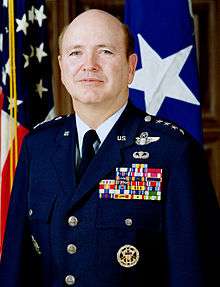 |
General Hansford T. Johnson, USAF | 1989 | 1992 |
| 3. | 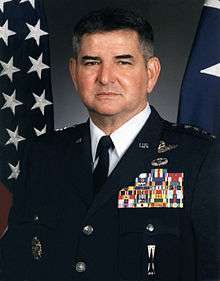 |
General Ronald R. Fogleman, USAF | 1992 | 1994 |
| 4. |  |
General Robert L. Rutherford, USAF | 1994 | 1996 |
| 5. |  |
General Walter Kross, USAF | 1996 | 1998 |
| 6. |  |
General Charles T. Robertson Jr., USAF | 1998 | 2001 |
| 7. |  |
General John W. Handy, USAF | 2001 | 2005 |
| 8. |  |
General Norton A. Schwartz, USAF | 2005 | 2008 |
| 9. | 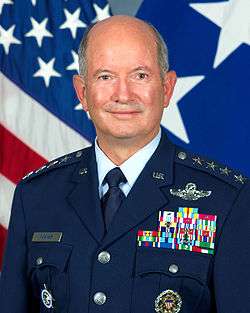 |
General Duncan J. McNabb, USAF | 2008 | 2011 |
| 10. |  |
General William M. Fraser III, USAF | 2011 | 2014 |
| 11. |  |
General Paul J. Selva, USAF | 2014 | 2015 |
| 12. | General Darren W. McDew, USAF | 2015 |
See also
Sources
This article includes text from the public domain USTRANSCOM Official Homepage.
External links
- USTRANSCOM Official Website
- Department of Defense Official Website
- Military Sealift Command Official Website
- Air Mobility Command Official Website
- Joint Enabling Capabilities Command Official Website
- Defense Logistics Agency Official Website
- Defense Security Cooperation Agency Official Website
- United States Maritime Administration Official Website
References
- ↑ http://www.defense.gov/About-DoD/DoD-101#How%20We're%20Organized
- ↑ http://www.defense.gov/About-DoD/Biographies/Biography-View/Article/618122/general-darren-w-mcdew
- ↑ "LTG Stephen R. Lyons" (PDF). Retrieved 2016-06-02.
- ↑ "United States Transportation Command". www.ustranscom.mil. Retrieved 2016-06-30.
- ↑ Lyle, Amaani. "New Commander Expresses Confidence in Transcom". u.s. Department of Defence. Retrieved 2016-02-03.
- ↑ U.S. Transportation Command public website, www.ustranscom.mil, accessed Sep. 14, 2016
- ↑ Pearson, David E. The World Wide Military Command and Control System evolution and effectiveness. DIANE Publishing. ISBN 978-1428990869. Retrieved 2016-02-03.
- ↑ Statement of General Darren W. McDew, Commander, United States Transportation Command, Before the House Readiness Subcommittee, On the State of the Command, 15 March 2016 http://docs.house.gov/meetings/AS/AS03/20160315/104661/HHRG-114-AS03-Wstate-McDewD-20160315.pdf
- ↑ Fehringer, Bob (2010-04-02). "Gates presents TRANSCOM with Joint Meritorious Unit Award" (Press release). Retrieved 2016-02-09.
